About ActiveCare Physical Therapy®
The Best Physical Therapists in NYC
-
Our therapists are licensed in New York State and active members in the American Physical Therapy Association. We have advanced training in joint mobilization and myofascial release techniques.
-
We are dedicated practitioners with a passion for the profession and a comprehensive, holistic approach to treatment and healing. We treat each patient as an individual and treat the whole person, with a plan of care designed to meet the patient’s set goals for health, functionality and a return to work, tasks and activities. We network with a team of physicians, chiropractors, acupuncturists and massage therapists in order to provide guidance to other modalities that may be effective in the patients’ care. We also offer superior Telehealth services for physical therapy.
-
Physical Therapist and owner Dr. Karena Wu PT, DPT, OCS is a graduate of the Program in Physical Therapy at Columbia University and is affiliated with several healthcare organizations in New York City. She is certified as a Strength and Conditioning Specialist, Kinesio Taping Practitioner and Pilates Instructor, and uses SpiderTech Taping. She is also a Certified Orthopedic Manual Therapist, Strength and Conditioning Specialist, Graston Technique® Specialist and Pilates Instructor. She holds LSVT BIG, FMS and SFMA Level 1 certifications as well. Dr. Wu also specializes in vertigo and temporomandibular joint disorders.
-
ActiveCare is primarily an out-of-network facility. We accept all insurance with out-of-network benefits and file for most major insurance plans. We work with all prospective patients to create workable payment plans regardless of insurance coverage.
-
ActiveCare accepts Medicare, No-Fault and Workers’ Compensation patients depending on schedule availability.
-
ActiveCare’s administrators provide seamless and efficient concierge-style client service to all of our patients. And the whole ActiveCare team makes sure your time with us is a beneficial, productive and enjoyable experience.
Quick Links
Manual Therapy Bursitis Plantar Fascitis Meniscus Tears Labral Tears Kinesiology Taping Pilates Rehab
Visit Our Main Website:
www.ActiveCarePhysicalTherapy.com
Blog Posts Are Below:
Category Archives: Best Physical Therapist for Ankle Sprain
Love Wearing Heels? 3 Options That Won’t Destroy Your Body
By Karena Wu, as published on mindbodygreen.
There is such a thing as love at first sight.
Like the first time you saw your now-favorite shoes on the shelf at a store: that whirlwind of ecstasy you felt at having finally found your ideal sole mate. Hearts melt for beautifully crafted heels.
The popular shoes are an iconic symbol for power and sexuality. Stilettos, boots, pumps, wedges … as long as there’s added height, the inner lift will be there, and a more confident you will emerge. Alluring yes, but time for the bad news: one of these days, those heels will walk all over you. As euphoric as leg-lengtheners can be, they come with a painful price.
As a physical therapist, I realize heel lovers are becoming too attached to their feisty footwear, completely disregarding their pain probability. It’s become my mission to educate women on the dangers of heels and eliminate their pain as much as possible.
My hope is you’ll read these six potential high heel issues and change your thoughts on sky high shoes:
1. Achy ankles
When wearing heels, your ankles are vulnerable. They’re not aligned in the most stable position, meaning there’s more movement in the joint. You might as well be auditioning for “Bambi On Ice” while you totter around on heels — that’s how unstable your ankles are.
Platform heels in particular reduce control in the forefoot. This means that movements aren’t as accurate or stable, inevitably leading to more stumbles and falls. Runway models … how do you do it?
2. Unlucky ligaments
There are three ligaments on the outside of your ankle versus five on the inside. This means that even on a level, flat surface, the outer ankle is far more vulnerable and prone to giving out. Now add in the four-plus inches of a skinny heel at an improbable angle … those ligaments are in danger.
3. Crying calves
Adding calf raises to your workout routine is a great way to strengthen your lower leg, but when your calves are permanently raised throughout the day (the position they’re in while wearing heels), they’ll start crying out. Wearing heels leaves our calves in a shortened position, causing the muscle to tighten more and for longer than they should.
4. Cramp crisis
The combination of tight muscles, tight heel cords and loose tendons in the front of the foot means more instability and irritation. If you wear heels, you’re probably all too familiar with charley horses in your legs and foot cramps.
5. Toe troubles
Even though there’s less weight on the forefoot while wearing heels (because of that aforementioned shortened calf), there’s still pressure that can lead to jamming of the toes (in closed-toe heels) or slippage of the toes (in opened-toe heels).
6. Unstable heels
When you walk in regular, flat shoes, your heel hits the pavement first, giving you support and stability. In high shoes your “heel” alone can’t support you because it has such a small surface area, so the rest of your foot has to compensate, often messing up the natural stride and rhythm of your walk.
Teetering in high heels limits natural strides — with more tension all around, the reduced stride length can lead to stiff knees and hips, shortened muscles, tight calves and plantar fascia.
So what’s a heel loving fool to do? Well, I know you don’t want to give up those lovely lengthening shoes altogether, so here are three shoe types that can give you a lift without all the pain:
- Wedge heels: They have a larger surface area, and more support and stability for foot/shoe contact with the ground.
- Platform heels: Platforms that are reasonably high (not five-plus inches!) allow your foot to be less plantar flexed (toes down) because of the raised toe bed. There’s also less weight in the ball of the foot because it’s more evenly distributed throughout the foot.
- Heels with ankle straps: The shoe stays on comfortably, so you don’t have to put in extra effort for balance.
Click here to read the original article, or visit us online at activecarephysicaltherapy.com to book an appointment.
Love Wearing Heels? 3 Options That Won’t Destroy Your Body
By Karena Wu, as published in MindBodyGreen
 There is such a thing as love at first sight.
There is such a thing as love at first sight.
Like the first time you saw your now-favorite shoes on the shelf at a store: that whirlwind of ecstasy you felt at having finally found your ideal sole mate. Hearts melt for beautifully crafted heels.
The popular shoes are an iconic symbol for power and sexuality. Stilettos, boots, pumps, wedges … as long as there’s added height, the inner lift will be there, and a more confident you will emerge. Alluring yes, but time for the bad news: one of these days, those heels will walk all over you. As euphoric as leg-lengtheners can be, they come with a painful price.
As a physical therapist, I realize heel lovers are becoming too attached to their feisty footwear, completely disregarding their pain probability. It’s become my mission to educate women on the dangers of heels and eliminate their pain as much as possible.
My hope is you’ll read these six potential high heel issues and change your thoughts on sky high shoes:
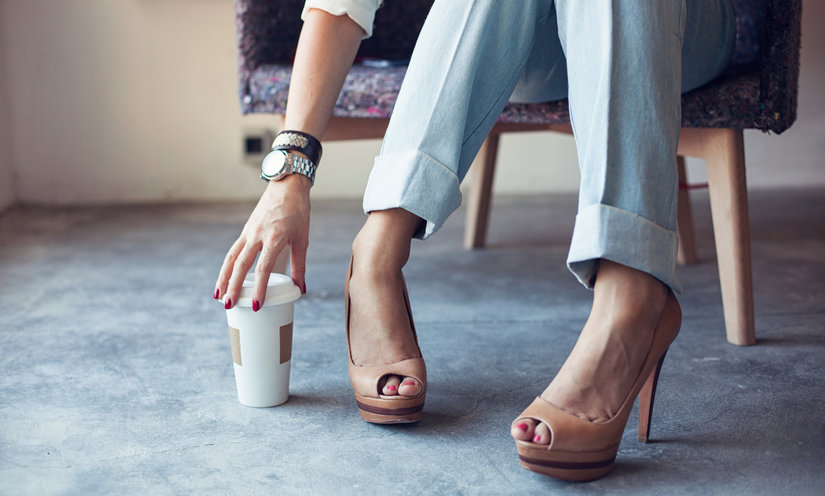
1. Achy ankles
When wearing heels, your ankles are vulnerable. They’re not aligned in the most stable position, meaning there’s more movement in the joint. You might as well be auditioning for “Bambi On Ice” while you totter around on heels — that’s how unstable your ankles are.
Platform heels in particular reduce control in the forefoot. This means that movements aren’t as accurate or stable, inevitably leading to more stumbles and falls. Runway models … how do you do it?
2. Unlucky ligaments
There are three ligaments on the outside of your ankle versus five on the inside. This means that even on a level, flat surface, the outer ankle is far more vulnerable and prone to giving out. Now add in the four-plus inches of a skinny heel at an improbable angle … those ligaments are in danger.
3. Crying calves
Adding calf raises to your workout routine is a great way to strengthen your lower leg, but when your calves are permanently raised throughout the day (the position they’re in while wearing heels), they’ll start crying out. Wearing heels leaves our calves in a shortened position, causing the muscle to tighten more and for longer than they should.
4. Cramp crisis
The combination of tight muscles, tight heel cords and loose tendons in the front of the foot means more instability and irritation. If you wear heels, you’re probably all too familiar with charley horses in your legs and foot cramps.
5. Toe troubles
Even though there’s less weight on the forefoot while wearing heels (because of that aforementioned shortened calf), there’s still pressure that can lead to jamming of the toes (in closed-toe heels) or slippage of the toes (in opened-toe heels).
6. Unstable heels
When you walk in regular, flat shoes, your heel hits the pavement first, giving you support and stability. In high shoes your “heel” alone can’t support you because it has such a small surface area, so the rest of your foot has to compensate, often messing up the natural stride and rhythm of your walk.
Teetering in high heels limits natural strides — with more tension all around, the reduced stride length can lead to stiff knees and hips, shortened muscles, tight calves and plantar fascia.
So what’s a heel loving fool to do? Well, I know you don’t want to give up those lovely lengthening shoes altogether, so here are three shoe types that can give you a lift without all the pain:
- Wedge heels: They have a larger surface area, and more support and stability for foot/shoe contact with the ground.
- Platform heels: Platforms that are reasonably high (not five-plus inches!) allow your foot to be less plantar flexed (toes down) because of the raised toe bed. There’s also less weight in the ball of the foot because it’s more evenly distributed throughout the foot.
- Heels with ankle straps: The shoe stays on comfortably, so you don’t have to put in extra effort for balance.
Click here to read the original article, and to book an appointment, visit www.activecarephysicaltherapy.com.
Photo Credit: Stocksy
Choosing High Heels That Are Safe
Spring is finally here, and many women are trading in their boots for high heels. But those strappy shoes may be causing you injuries! Watch ActiveCare Physical Therapy’s Karena Wu talk fashion vs. function on CBS New York:
To book an appointment with ActiveCare Physical Therapy, call (212) 777-4374 or visit www.activecarephysicaltherapy.com.
How to Stay Safe and Look Hot: Karena Wu on CBS
It’s finally time to put the winter boots away and step into a hot new pair of spring shoes! ActiveCare Physical Therapy’s own Karena Wu appeared on CBS New York to provide tips on how to rock your sexy new heels while staying safe wearing them. Click below to watch the video:
To book an appointment with ActiveCare Physical Therapy, call (212) 777-4374 or visit www.activecarephysicaltherapy.com.
Physical Therapy for Ankle Pain
Ankle Pain
Unfortunately, the ankle is one of the most commonly injured areas of the body. Because the ankles carry your entire weight during the majority of physical activity, it is very vulnerable to injury and thus pain. Even something as simple as stepping down with the ankle bent incorrectly can cause muscular damage and result in pain. 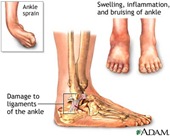
The ankle houses a large number of ligaments, tendons, and muscles all working together to move the joint during motion. Individually these pieces can be injured easily, leaving you with a constant source of pain and limited use of your ankle. Physical therapy (PT) seeks to provide pain relief for your ankle while working to return full functionality to have you back on your feet in no time.
Causes of Ankle Pain
One of the most general causes of ankle pain is a sprain in the ankle, which is one of the more common injuries suffered by those who lead active lives. Sprained ankles result from an overstretching of the ligament, creating either a complete or partial tear in the ligament. The severity of the sprain is directly linked to the size of this tear. Ankle sprains can cause a large amount of pain and will inhibit your ability to use your ankle. 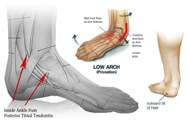
Other conditions that may cause you to feel pain in the ankle may include:
· Arthritic inflammation
· A stress related fracture
· Pain that results from a complication in the foot
Physical Therapy for Ankle Pain
Treating Ankle Pain
Our physical therapists are well versed in the treatment of ankle pain and will be able to provide you pain relief while helping restore functionality to your ankle. Treatments used will be based on the origin of your pain, and may include rehabilitation, medication, stretching exercises, and strength training to better prevent a future injury. One of the best things you can do for your ankle prior to our treatment is to keep weight off of it as much as possible in order to let the muscles rest.
An Ankle Sprain Could Require Physical Therapy
Having an ankle sprain is an unfortunately common injury, and countless people suffer from sprains each year. Some people do not always realize the extent of their injuries, especially right after it happens. They may continue to walk on their ankle in an attempt to “walk it off”, which could lead to the injury becoming even more problematic. When you have what you believe might be an ankle sprain, you are going to want to take weight off the injured area right away. You will want to contact a physical therapist to get you back on your feet quickly.
What Causes Ankle Sprains?
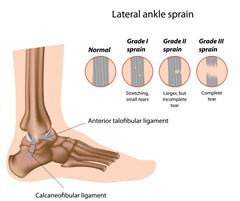 The ankle is one of the most important joints in the body, but it also suffers quite a bit of abuse. When people are running, hiking, jumping, and even just walking down the street, there is a possibility of twisting the ankle and injuring it. Sports, and simply tripping and falling, are some of the most common reasons for sprains and the subsequent need for physical therapy.
The ankle is one of the most important joints in the body, but it also suffers quite a bit of abuse. When people are running, hiking, jumping, and even just walking down the street, there is a possibility of twisting the ankle and injuring it. Sports, and simply tripping and falling, are some of the most common reasons for sprains and the subsequent need for physical therapy.
The sprain happens when there is too much plantar flexion and inversion – when the toes point inward. Tears in the ligaments then occur. Often the tear takes place in the anterior talofibular ligament, or the ATFL, but tears can occur in other ligaments as well, such as the CFL and the PTFL. CFL stands for the calcaneofibular ligament, and PTFL stands for posterior talofibular ligament. These ligaments are very important, as they are what help to keep your ankle in place. In an ankle sprain, the ligaments can overstretch and tear and this is what the term ‘sprain’ refers to.
When you sprain your ankle, it is going to cause pain, which is often immediate. You will also notice swelling in the ankle, and possibly some instability in the lateral ankle. You need to make sure that you heal your ankle properly so get into your physical therapist as soon as you can.
How Severe is the Tear?
Different terminology is used when determining the severity, or the grade, of the tear. A high-grade tear is more severe than a low-grade tear, which usually means a full tear versus a partial tear. Your physical therapist is going to be able to determine and explain the grade of your tear as well as what you will have to do to get healthy again.
Treatment for Ankle Sprains
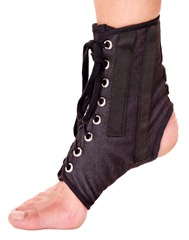 You will want to treat your sprain right away. Initially, this means that you are going to want to rest the ankle, apply ice, compress the ankle gently, and elevate it to help control the swelling. This is the immediate treatment for a sprain, and your doctor may give you some medications to help you deal with the pain. Healing of the ankle can take about six weeks in most cases, but it could take longer. You might find quite a bit of stiffness in your joints, and the best course of action is going to be physical therapy. Proper therapy will ensure that you are able to get full range of motion to your ankle, and improve your balance while improving strength. Your physical therapist can do this, as well as ultrasound, electronic stimulation, soft tissue mobilization, and exercises.
You will want to treat your sprain right away. Initially, this means that you are going to want to rest the ankle, apply ice, compress the ankle gently, and elevate it to help control the swelling. This is the immediate treatment for a sprain, and your doctor may give you some medications to help you deal with the pain. Healing of the ankle can take about six weeks in most cases, but it could take longer. You might find quite a bit of stiffness in your joints, and the best course of action is going to be physical therapy. Proper therapy will ensure that you are able to get full range of motion to your ankle, and improve your balance while improving strength. Your physical therapist can do this, as well as ultrasound, electronic stimulation, soft tissue mobilization, and exercises.
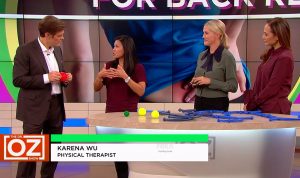 ActiveCare Physical Therapy, PC
ActiveCare Physical Therapy, PC
29 West 38th Street
Suite 601
New York, NY 10018


